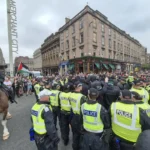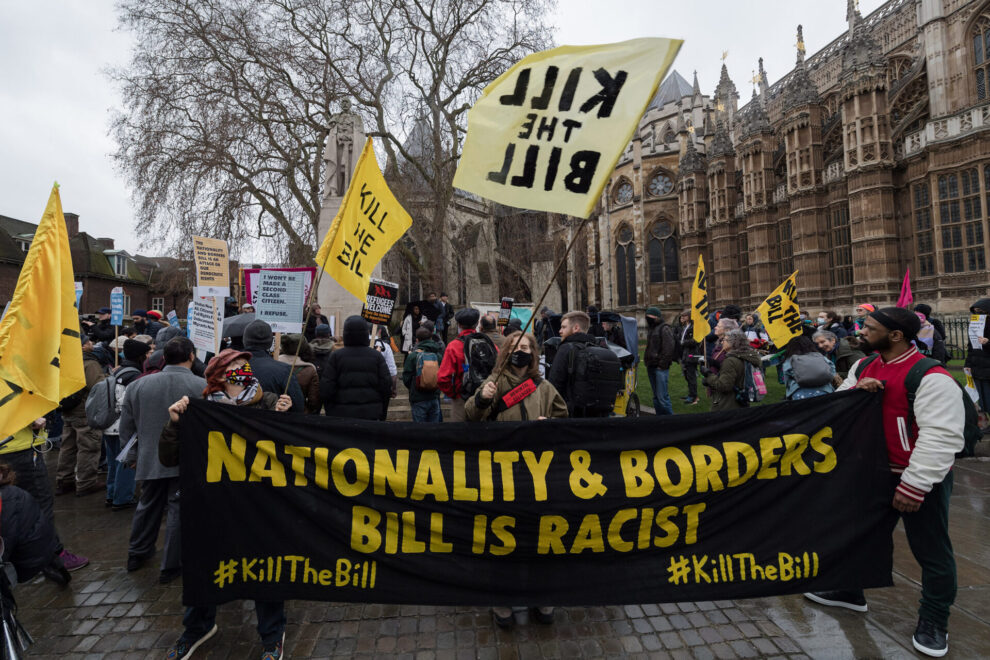Decades of study expose this legislation as the perfect playbook for turning peaceful events into scenes of chaos and disorder
he government is to introduce legislation this week that, according to Downing Street, is designed to stop such heinous tactics as “slow marching”, and will mean that police “will not need to wait for disruption to take place and can shut protests down before chaos erupts”.
As I read this story, it seemed strangely familiar. Where had I heard it before? In a history of some emerging authoritarian regime? In the playbook of Steve Bannon or his equivalent? And then I remembered the Christmas of 1973. My favourite present was The Brand New Monty Python Papperbok, and my favourite piece was on “LLAP-Goch”, a self-defence system “that requires NO INTELLIGENCE, STRENGTH or PHYSICAL courage”.
LLAP-Goch involves attacking your assailant before he attacks you. “or BETTER… BEFORE the THOUGHT of doing so has EVEN OCCURRED TO HIM!!!” (If you’re wondering about the capitals, it’s because the sort of person who buys into this nonsense “HAS less trouble under-sTANDING words if they ARE written in BIG letters”.)
Now the absurdist imagination of the Monty Python team has been translated into policy by Rishi Sunak. His government intends to empower the police to stop protesters causing disruption, even when they aren’t causing disruption. It isn’t a spoof. It isn’t remotely funny. But it remains just as absurd. For if the government thinks that such legislation will do anything to limit protest or stop conflict, they will soon discover just how wrong they are.
History shows that attempts to suppress dissent through indiscriminate repression have precisely the opposite effect. Such an approach generally recruits more dissenters and radicalises their actions. It creates, rather than pre-empts, chaos.
In America on Fire, a searing account of relations between black people and police in the US during the late 1960s and early 1970s, Elizabeth Hinton refers to “the cycle”. Protests against racial inequality were treated as a “law and order” problem, to be met by an increasingly heavy policing and legislative response. This in turn compounded the original sense of injustice and provoked more protest – and so demonstrations became confrontations and confrontations became armed conflicts.

Between 1968 and 1972 President Lyndon Johnson’s strategy of preventing disorder “with muscle and with toughness” resulted in 1,949 disturbancesduring which 40,000 people were arrested, 10,000 injured and 220 killed. “The cycle” continues to this day in the era of Black Lives Matter protests, with many states – such as Oklahoma – passing laws that criminalise acts such as blocking a public street.
Of course, there are many differences between the US and the UK, between black struggle and environmental action. But Hinton’s general account of the cycle applies to both countries and both causes. So does her concluding question, “Will the cycle be broken before the fires consume us all?” – the question has a further layer of significance when it comes to environmental protests about our burning planet.
Over the last 20 years or so, my colleagues and I have been looking in more detail at precisely how different forms of policing crowds lead either to the escalation or the de-escalation of conflict and, from all we have learned, it is clear that the measures the UK government is proposing will have multiple toxic consequences.
First, conflict is generally less to do with the police doing things the crowd doesn’t like or stopping crowd members doing what they want to do. It is more a matter of legitimacy – protesters seeing the police as either doing things they have no right to do, or else preventing crowd members from doing things they do have a right to do. If the police impede actions that everyone in the crowd sees as a basic right, then they can unite even the most diverse and fractious crowd against them. In the case of the proposed legislation, intervening against crowds even in the absence of disruptive behaviour is likely to have such an effect.
Second, by providing the police with both the power and the discretion to disrupt protests, then they become the enemy – the “system” made flesh and blood. Whatever a protest might originally have been about, and whatever its initial targets – say oil companies or government in the case of environmental protest – the police will become a more tangible target. The fact that they might intervene at any moment means that their mere presence will be enough to invoke suspicion and resentment.
Third, the more the police are given discretion as to when to apply draconian powers, the greater the space for stereotypes and prejudices to affect their judgments. Certain groups will be seen more likely to be potentially disruptive. Hence, intervention is more likely against these groups, and those who already have a troubled relationship with the police are likely to be further alienated.
Fourth, once you make protest more conflictual many people – especially families, disabled people, older people, members of vulnerable groups – will be deterred from joining in. Gradually, participation will be reduced to those who are comfortable with a fight. Not only is this at odds with the democratic (and human rights) imperative to make protests a safe space in which all sections of community feel able to participate, it also constitutes another path to making conflict more likely.
It is clear that these powers will not help the police, but rather undermine their relationships with the communities they serve, expose them to more hostility, and make disruption more likely. That is why in public they ask for more clarity about when to intervene, not more discretion. In private, many of the senior officers I have spoken to react to the government’s “muscular” tone in terms verging on despair.
Protesters and police alike recognise that this legislation will not reduce disruption. And perhaps it is not designed to do so. As the Monty Python team realised a half century ago, such performative assertions of strength are generally an attempt to distract from an underlying vulnerability. “No longer need you feel WEAK, helpless, INDECISIVE.. No more need you be out-manoeuvred in political debate!!”, they wrote.
Always beware the show of strength by weak governments.
Stephen Reicher is a professor of psychology at the University of St Andrews
















